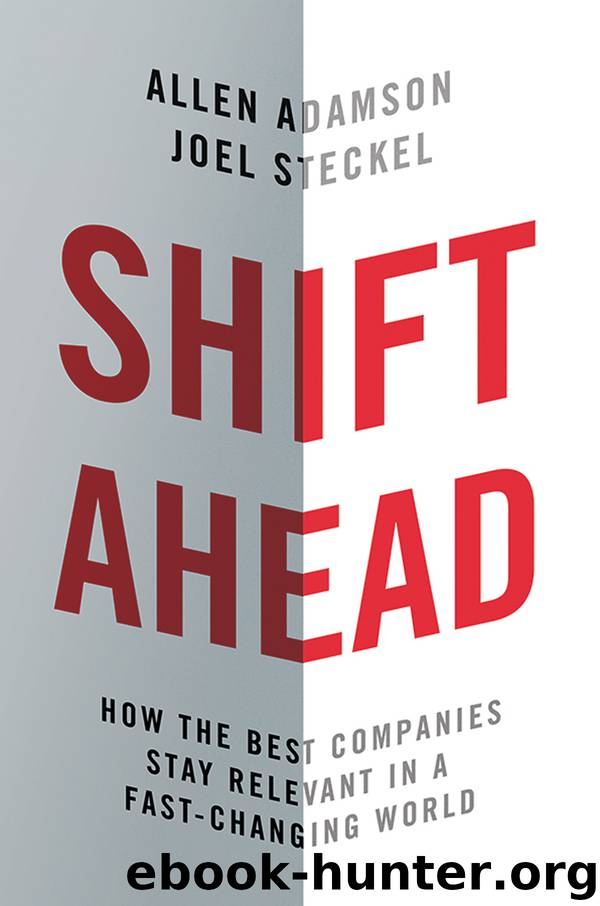Shift Ahead by Allen Adamson

Author:Allen Adamson
Language: eng
Format: epub
Publisher: AMACOM
Published: 2017-04-04T04:00:00+00:00
IBM:
A Legacy of Continued Shifting
Some organizations are built for rapid gear shifting from the get-go. Everything is set up to enable the company to shift gears quickly and fluidly, from organizational structure to the open-communications policy to the process for fast-tracking ideas. For example, Facebook is a technology company that was established to outpace the fast pace of change. IBM is different. Founded in 1911 as a maker of scales, cheese and meat slicers, coffee grinders, and the like, IBM eventually got into the business of making computers. Then it got out of the business of computers and into business enterprise solutions. IBM has been very adept at shifting direction.
Our conversation with IBM senior vice president of marketing and communications, Jon Iwata, suggests that they view it otherwise. IBM has never defined business as what it sells, but rather, what it believes in. At IBM’s core are a set of values that have remained constant over the years, even as what they’ve done to meet their customers’ needs has changed. It is because of this that IBM has been able to shift by degrees while keeping the positive equity in its brand. It may not shift gears as quickly and with the same agility as a Facebook, of course, because of its age (let’s call it advanced middle age) and because of its magnitude relative to other tech companies; nonetheless, IBM makes it happen with authority.
Before we get to Iwata’s more detailed insight, it is worthwhile to give a brief overview of two famous examples of IBM’s shifts. First, in 1993, the once-dominant computer company was on the verge of a breakup. The stock price had hit a twenty-year low. The company that had always maintained a lifetime employment policy let go more than 100,000 employees after posting an $8.1 billion loss. Worse, IBM’s way of computing and of working with customers was viewed as antiquated. The company struggled under the weight of a management structure that created independent business units with redundant processes and disconnected information systems. Because of years of operating with few competitors, it had become insular and slow to react to change.
Enter Lou Gerstner, former president of American Express and CEO of RJR Nabisco. While industry pundits assumed Gerstner was brought in to accelerate a breakup of the company into smaller units, Gerstner did just the opposite. He pushed it together, creating a much more streamlined and integrated company. He understood that IBM’s inherent strength was in its ability to solve complex (business) problems for its customers. To create value through total solutions, IBM had to become an adviser, not just a vendor. This initiative resulted in a campaign, and a way of doing business, called “Solutions for a Small Planet.” The word solutions critically expressed the core of IBM’s values and belief system.
From the outside, this shift—from manufacturing to advising—might have seemed incongruous with the company’s origins. The fact is, however, that IBM had always had a consulting component to its sales. The big mainframes you’d buy from IBM were not just plug and play.
Download
This site does not store any files on its server. We only index and link to content provided by other sites. Please contact the content providers to delete copyright contents if any and email us, we'll remove relevant links or contents immediately.
Bad Blood by John Carreyrou(6274)
Rich Dad Poor Dad by Robert T. Kiyosaki(6174)
Principles: Life and Work by Ray Dalio(5957)
Playing to Win_ How Strategy Really Works by A.G. Lafley & Roger L. Martin(5494)
Management Strategies for the Cloud Revolution: How Cloud Computing Is Transforming Business and Why You Can't Afford to Be Left Behind by Charles Babcock(4438)
The Confidence Code by Katty Kay(4035)
Thinking in Bets by Annie Duke(3996)
American Kingpin by Nick Bilton(3507)
Delivering Happiness by Tony Hsieh(3280)
Project Animal Farm: An Accidental Journey into the Secret World of Farming and the Truth About Our Food by Sonia Faruqi(3016)
The Power of Habit by Charles Duhigg(2964)
Brotopia by Emily Chang(2892)
Mastering Bitcoin: Programming the Open Blockchain by Andreas M. Antonopoulos(2891)
The Tyranny of Metrics by Jerry Z. Muller(2846)
I Live in the Future & Here's How It Works by Nick Bilton(2844)
The Marketing Plan Handbook: Develop Big-Picture Marketing Plans for Pennies on the Dollar by Robert W. Bly(2792)
The Content Trap by Bharat Anand(2778)
Building a StoryBrand by Donald Miller(2754)
Applied Empathy by Michael Ventura(2749)
